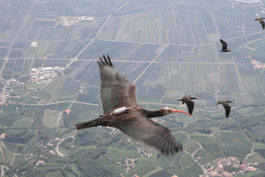Sensor Housings for Avian Harnesses
Custom Biologger Housing For Birds

Bird Sensor Housings. Various external attachment techniques have been developed that indirectly attach biologgers and transmitters to birds via a neck collar, backpack, harness or leg band. Neck collars and backpacks generally have excellent transmitter retention (often for the life of the bird). Various harness designs are available that provide better fits to particular species because poorly fitting harnesses may cause abrasions or impede wing movement. In addition, the design of a biologger housing, attached to the harness via a base plate, must often be adapted to specific species and the requirements set by the applied sensors, i.a. in terms of size and antenna positions. However, size and shape of sensor housing can have a significant impact on the drag coefficient. Here, a streamlined shape, proper dimensions, and a reduced frontal area may reduce drag. In an experimental wind tunnel setup, Obrecht et al. (1988) found that adding a rounded fairing to the front end and a pointed fairing behind helped reduce the drag of the transmitter by about one-third compared to a rectangular box. Recently, Mizrahy-Rewald et al. (2023) reported on how the shape of biologger housings can have a considerable effect on heart rate and VeDBA of Northern Bald Ibises - both parameters have been used as proxies for energy expenditure.
Please contact us to discuss your needs in sensor housings for avian harnesses. For adaptation to available sensors and harnesses, a detailed 3D-model or a hands-on test are strongly advisable. See this recent blog post on how biologging sensor housings have been used in research by Mizrahy-Rewald et al. (2023).
Application of Biologger / Sensor Housings in Avian Research
Bird Biologger Sensor Housings are specially designed enclosures used to house and protect Biologgers, which are small electronic devices used to study bird behaviour and physiology. These sensor housings are typically lightweight, durable, and designed to minimize interference with the bird's natural movements and activities. The enclosures are carefully designed to be non-invasive and comfortable for the birds, allowing them to perform their normal behaviours without significant disruption. They are often constructed of environmentally resistant materials, such as waterproof and weatherproof materials, to protect the sensitive sensors inside from moisture and damage.
Sensor enclosures contain a variety of sensors and data collection devices, such as accelerometers, GPS trackers, temperature sensors, and heart rate monitors. These devices allow researchers to collect valuable data on the bird's flight patterns, feeding behaviour, environmental preferences, and physiological responses.
The data collected can provide insights into the bird's migratory patterns, breeding behaviour, and responses to environmental changes. Researchers can use this information to better understand the ecology and conservation needs of bird species, helping to inform conservation efforts and management strategies.
Overall, Bird Biologger Sensor Housings play a critical role in the field of avian research, allowing scientists to gather accurate and detailed data on bird behaviour and physiology while minimizing any negative impact on the birds themselves.
| References | External Animal Attachments / Biologger Housings | OPEN |
|
||






